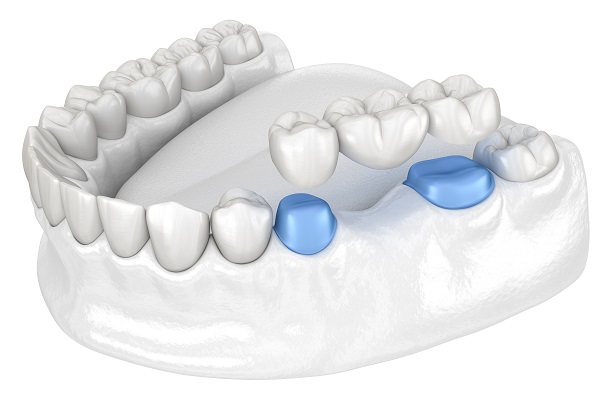How a Dental Bridge Addresses a Missing Tooth

In dentistry, a dental bridge is one of the popular options for closing the gap left by a lost or extracted tooth. Bridges are typically made up of crowns on the sides of the gap, which cover adjacent health teeth, called the abutment teeth. These teeth support the replacement teeth, which could be one or more. For fixed prosthetics, the bridge is cemented permanently onto the healthy teeth, thus literally bridging the gap left by the lost teeth.
How a dental bridge is used for replacing a missing tooth
When it comes to using a dental bridge for tooth replacement, there are three major options. The materials used for fabricating the bridge typically include metal and porcelain. The dentist will determine the type of bridge that best addresses the needs of the patients and discuss these options before commencing the process. The types of dental bridges include:
- Traditional fixed bridge: This restoration works by affixing the false tooth to a crown placed over the adjacent teeth for support
- Cantilever bridge: This option is similar to the fixed bridge, except that the false tooth is bonded to only one tooth instead of two
- Maryland bridge: These bridges are often used for front teeth to improve the smile’s appearance. It is also called a resin-bonded bridge and is fitted with metal or porcelain wings for support
Benefits of choosing dental bridges
There are many benefits to enjoy with dental bridges. They can help to strengthen damaged teeth, as well as enhance the appearance, alignment, bite, and shape of the teeth. By filling the gap left by the lost teeth, patients can prevent the existing teeth from shifting out of place. The bridge also stays securely in place and does not move around in the mouth. If the nearby teeth are decayed or damaged, the crown that comes with the dental bridge will cover and fortify them.
Getting a dental bridge
The dental bridge placement procedure is a multi-stage process that requires more than one dental appointment. In the first step, the dentist will administer a local anesthetic into the gum tissue before proceeding to reshape the teeth that will hold the crowns. Tooth preparation requires filing down part of the enamel layer to make the crowns fit securely.
After shaping the teeth, the dentist will make impressions of the lost tooth and the nearby teeth. The impression is forwarded to a dental lab to produce a bridge that fits the patient correctly. Until the final bridge is ready, patients will get a temporary bridge to protect the prepared teeth and cover the gap in the smile.
The permanent bridge should be ready in a few weeks, after which the patient will return to the dental office for placement. The dentist will check the bridge to ensure it aligns well with the remaining teeth and the bite.
Do you have one or more missing teeth?
If you have a missing tooth and think you might benefit from a dental bridge, book an appointment with our dentist for a consultation.
Request an appointment here: https://dentistofmontville.com or call Montville Smiles at (973) 302-2079 for an appointment in our Montville office.
Check out what others are saying about our dental services on Yelp: Dental Bridges in Montville, NJ.
Related Posts
Replacing lost teeth with a dental bridge has many advantages. Tooth loss does not just affect the appearance of the smile, but also the ability to talk and chew easily, teeth alignment, and the person’s confidence. A dental bridge closes the gap between teeth and prevents further damage. Read on to find out how bridges…
A dental bridge is a common dental restoration used for replacing lost teeth, whether the loss was due to trauma, structural damage, infection or decay. The dental bridge is as the name implies; a bridge over the gap created by a missing tooth. The teeth on the sides of the gap function as anchors and…
Dental bridges can be an effective solution for patients with missing teeth. The gap left by the lost tooth can make eating and speaking harder than usual. A dental bridge replaces the lost tooth with a prosthetic crown, anchoring it with healthy teeth on either side of the gap. In this article, you will learn…
Think you might need a dental crown? Read on to learn more about this restoration. Dental crowns play an essential role in restorative dentistry and are used primarily for correcting damage to the teeth. According to the Centers for Disease Control (CDC), 91% of Americans over the age of 20 have had cavities. Dental crowns…
